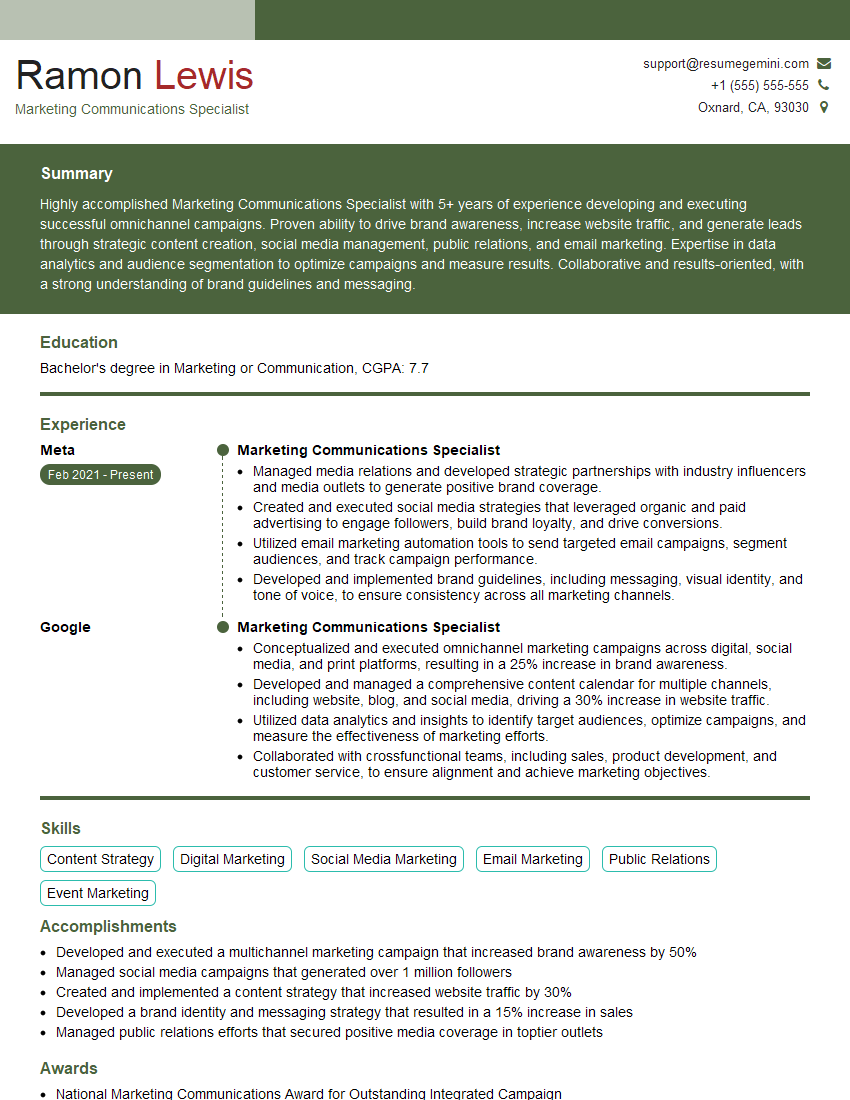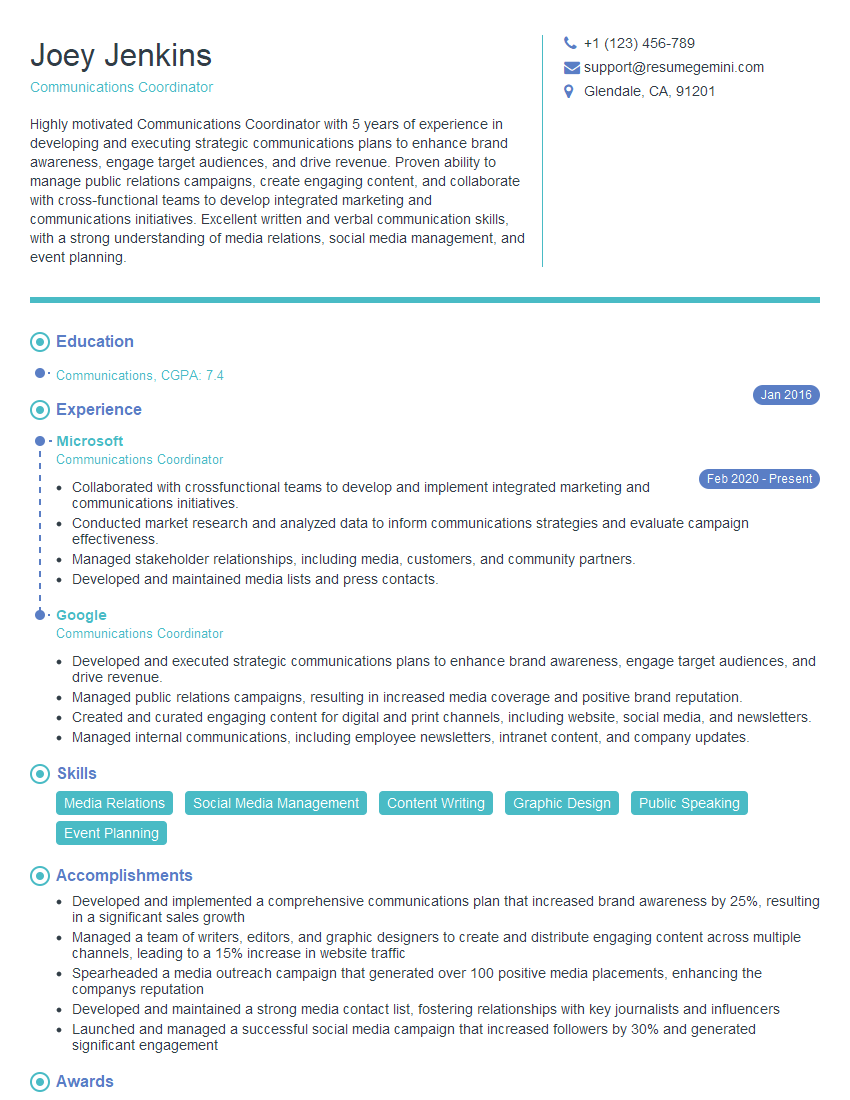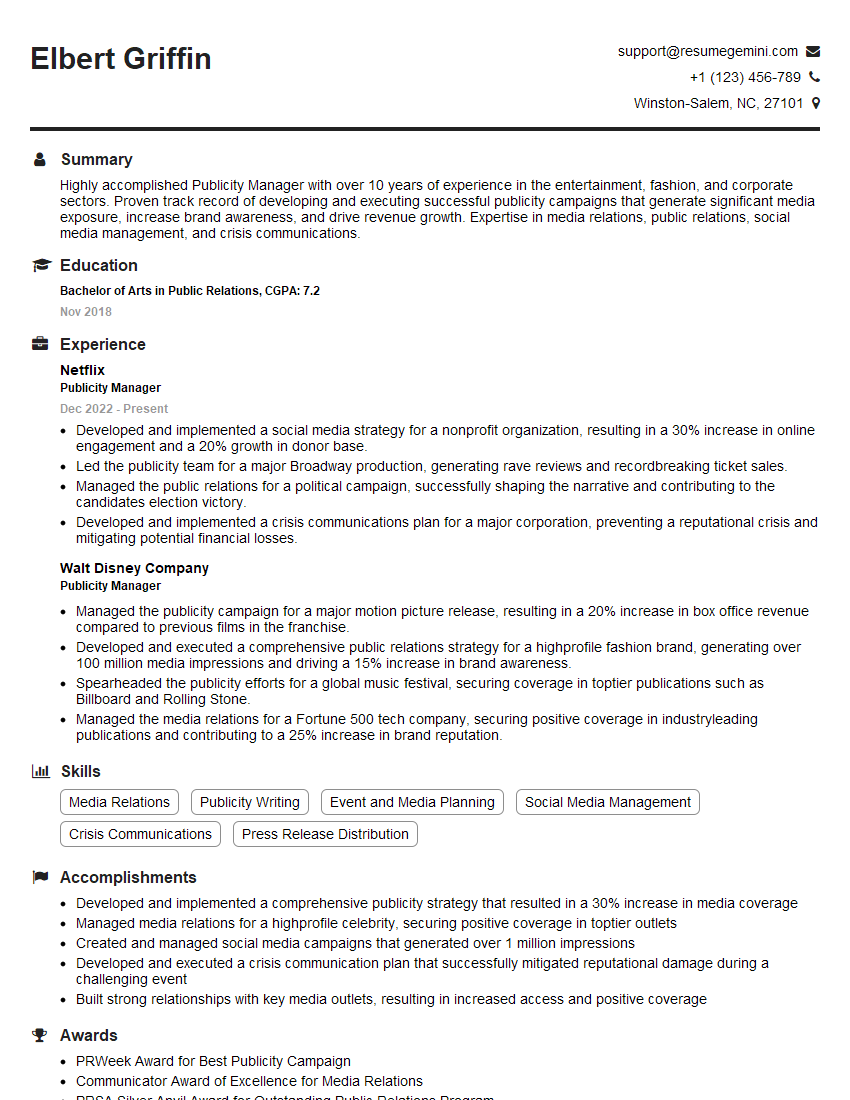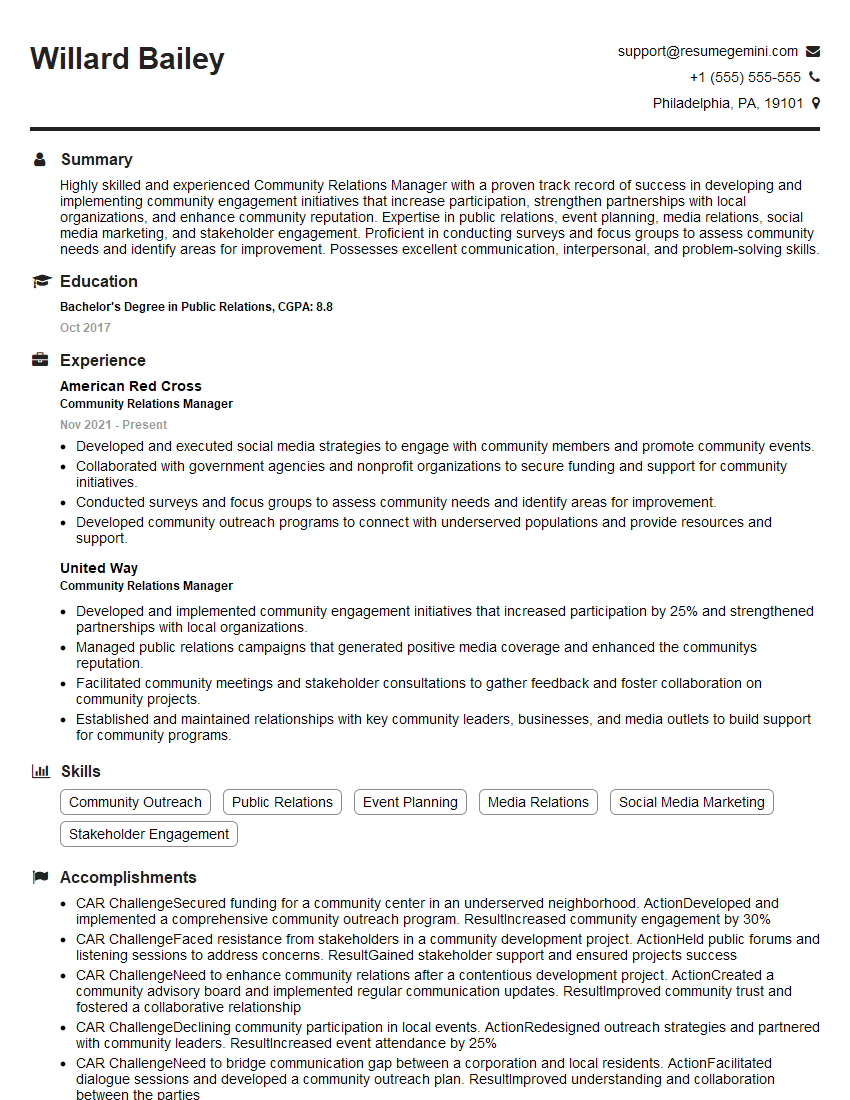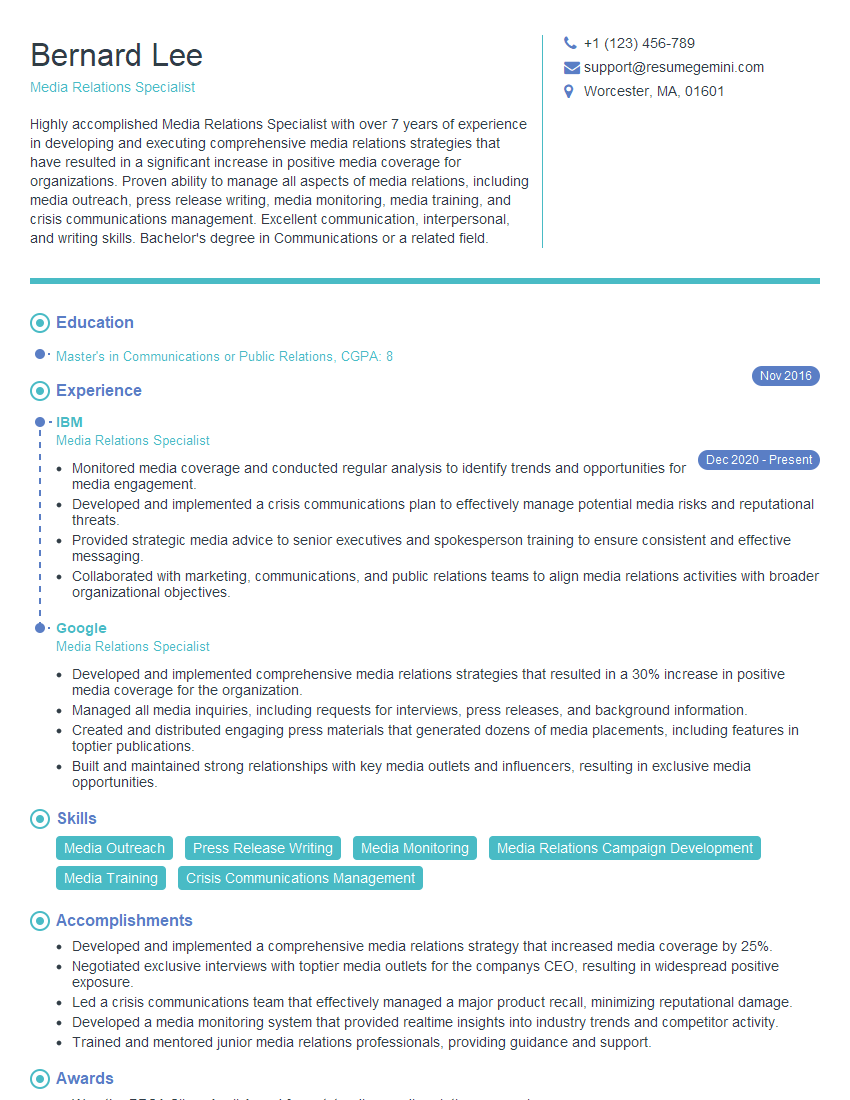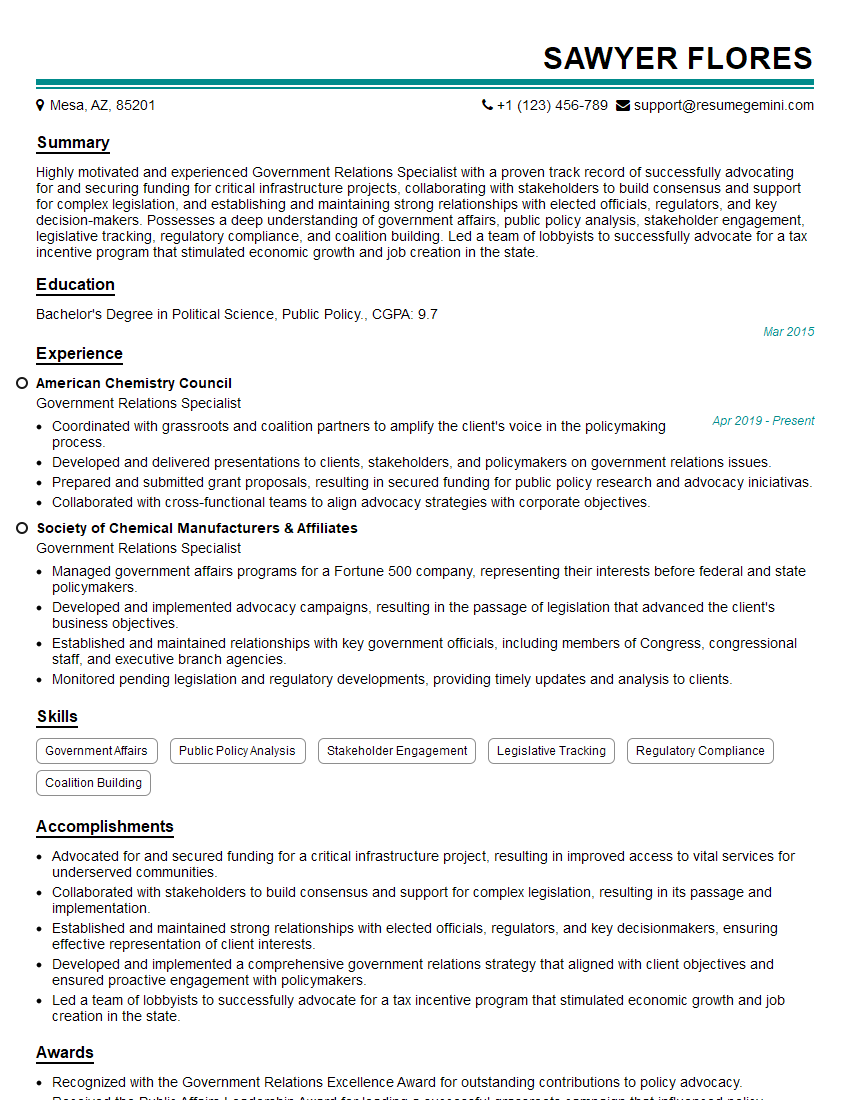Interviews are opportunities to demonstrate your expertise, and this guide is here to help you shine. Explore the essential CommunicationWithExternalStakeholders interview questions that employers frequently ask, paired with strategies for crafting responses that set you apart from the competition.
Questions Asked in CommunicationWithExternalStakeholders Interview
Q 1. Describe your experience managing relationships with external stakeholders.
Managing relationships with external stakeholders requires a multifaceted approach encompassing proactive engagement, consistent communication, and a deep understanding of their needs and expectations. My experience spans various sectors, including [mention specific sectors, e.g., technology, finance, non-profit], where I’ve successfully cultivated and nurtured relationships with diverse stakeholder groups, such as investors, government agencies, media outlets, and community organizations. This involved not only regular communication updates but also actively soliciting feedback and addressing concerns promptly. For example, in my role at [previous company name], I spearheaded a community engagement initiative that significantly improved our relationship with local residents who had previously voiced concerns about our operations. This involved organizing town hall meetings, creating a dedicated communication channel (e.g., newsletter, online forum), and implementing a transparent feedback mechanism.
Q 2. How do you tailor your communication style to different stakeholder groups?
Tailoring communication is crucial for effective stakeholder management. I adapt my style based on factors such as the stakeholder’s level of technical expertise, their preferred communication channels, their relationship with the organization, and their overall communication preferences. For instance, when communicating with investors, I prioritize concise, data-driven presentations focusing on key performance indicators and financial projections. In contrast, when engaging with community groups, I adopt a more conversational and empathetic approach, focusing on the social impact of our work and addressing their concerns directly. This might involve using simpler language, avoiding technical jargon, and utilizing visual aids to enhance understanding. I also leverage different communication channels strategically – email for formal updates, social media for informal engagement, and in-person meetings for building rapport.
Q 3. Explain your approach to crisis communication with external stakeholders.
My approach to crisis communication prioritizes transparency, speed, and empathy. The first step involves swiftly assessing the situation, identifying the key stakeholders affected, and developing a clear, consistent message. Transparency is paramount; we acknowledge the issue, explain what happened, and outline the steps we’re taking to address it. We actively engage with stakeholders through various channels, providing regular updates and addressing their concerns directly. We also proactively manage the narrative, combating misinformation and emphasizing our commitment to resolving the crisis. For example, during a product recall incident at [previous company name], we promptly issued a press release, established a dedicated hotline and website, and engaged directly with affected customers through email and social media to provide updates and support. This proactive and transparent approach mitigated the damage and maintained stakeholder trust.
Q 4. How do you measure the effectiveness of your external communication strategies?
Measuring the effectiveness of external communication requires a multi-faceted approach. We use both qualitative and quantitative methods. Quantitative metrics include website traffic, social media engagement (likes, shares, comments), media mentions, and survey responses. Qualitative measures include stakeholder feedback obtained through focus groups, interviews, and informal conversations. By analyzing this data, we can assess the reach, resonance, and impact of our messages. For example, a post-campaign survey revealed that 80% of respondents felt better informed about our company’s initiatives after receiving our quarterly newsletter, indicating the success of this communication channel. We continuously analyze this data to optimize our strategies and ensure we’re communicating effectively with our stakeholders.
Q 5. Describe a time you had to manage conflicting messages from different stakeholders.
In a previous role, we faced conflicting messages from the executive team and the marketing department regarding a new product launch. The executive team wanted to emphasize the product’s technical features, while the marketing department focused on its consumer benefits. To resolve this conflict, I facilitated a meeting involving key stakeholders from both teams. We collaboratively defined target audiences and tailored messaging to each group’s needs and priorities. This involved creating a unified messaging framework that incorporated both the technical specifications and the consumer benefits in a balanced and cohesive manner. The result was a successful product launch with positive feedback from both technical experts and the general public, demonstrating the importance of clear communication and collaborative decision-making in managing conflicting messages.
Q 6. How do you utilize social media for external communication?
Social media is a powerful tool for external communication, enabling two-way dialogue and rapid dissemination of information. My approach involves using various platforms strategically depending on the target audience and communication objectives. For instance, LinkedIn is ideal for engaging with professionals and industry experts, while Twitter is great for sharing quick updates and responding to immediate queries. Facebook and Instagram can be effective for broader audience engagement. We use social media to share news, updates, events, and thought leadership content. We also actively monitor social media channels for feedback and to address concerns quickly. Importantly, we maintain a consistent brand voice and engage authentically with our followers. This ensures effective communication and builds a stronger relationship with our stakeholders.
Q 7. How do you build and maintain trust with external stakeholders?
Building and maintaining trust with external stakeholders is an ongoing process. It’s built upon several pillars: transparency, honesty, responsiveness, and consistent communication. Transparency involves openly sharing information, even when it’s not entirely positive. Honesty means being truthful and forthright in our communications. Responsiveness entails promptly addressing stakeholder concerns and providing timely updates. Consistent communication ensures stakeholders feel informed and engaged. We also actively solicit feedback and demonstrate a willingness to adapt our approach based on stakeholder input. For example, regularly conducting stakeholder surveys and incorporating the feedback into our communications strategy helps to build trust and rapport over time. Ultimately, consistent and transparent actions are crucial in building and maintaining long-term trust with our external stakeholders.
Q 8. Explain your experience in media relations and press releases.
My experience in media relations and press releases spans over seven years, encompassing everything from crafting compelling narratives to distributing them effectively. I’ve successfully secured media coverage in major publications and online platforms for various clients, significantly boosting their brand visibility and reputation.
For example, when working with a tech startup launching a new software, I crafted a press release highlighting its unique features and market impact. This release, strategically targeted to relevant tech journalists, resulted in features in several prominent publications, driving substantial traffic to the company website and generating significant lead generation. Another example involves managing the crisis communication surrounding a product recall; through swift and transparent communication with the media, we mitigated negative impact and maintained public trust.
My process typically involves understanding the key message, identifying the target audience of journalists, tailoring the press release to their interests, and actively building relationships with media contacts to ensure placement.
Q 9. What strategies do you use to proactively manage external communication?
Proactive external communication management hinges on anticipating potential issues and opportunities and building relationships before crises arise. This includes regular monitoring of social media, news outlets, and industry trends to identify emerging concerns or positive narratives. I employ several strategies: regular newsletters, proactive media outreach, social media engagement, and community involvement.
For instance, for a client facing upcoming regulatory changes, I developed a series of blog posts and social media updates explaining the implications and steps taken to ensure compliance. This helped manage expectations and preempt potential negative narratives. I also regularly schedule briefings for key stakeholders to keep them informed and engaged.
- Regular Newsletters: Providing consistent updates to stakeholders.
- Social Media Monitoring: Identifying and responding to mentions proactively.
- Proactive Media Outreach: Pitching stories and building relationships with journalists.
- Stakeholder Briefings: Keeping key groups informed and engaged.
Q 10. How do you identify key stakeholders and prioritize communication efforts?
Identifying and prioritizing key stakeholders requires a strategic approach. It’s not just about size or influence, but also about their impact on your organization’s goals. I employ a multi-faceted approach combining internal data and external research.
Firstly, I analyze internal data like sales figures, customer segmentation data and engagement metrics to identify the most influential customer groups. Next, I conduct external research to identify relevant industry influencers, media outlets, regulatory bodies and community leaders. A stakeholder map is crucial here – visually representing stakeholders’ relationships and their relative influence. Prioritization involves considering urgency, importance, and potential impact of each stakeholder group.
For example, during a product launch, media outlets and key industry bloggers would take precedence, while during a crisis, government agencies and affected customers become the top priority.
Q 11. How do you handle negative feedback or criticism from external stakeholders?
Handling negative feedback and criticism requires a calm, responsive, and transparent approach. It’s crucial to avoid defensiveness and instead focus on understanding the concerns and addressing them directly. My approach involves acknowledging the feedback, showing empathy, investigating the issue, and offering a solution or plan of action.
For example, if a customer expresses negative feedback on social media, I acknowledge their frustration, investigate the issue, and offer a sincere apology if appropriate. Then, I explain the steps taken to address the problem and offer a solution, such as a refund or replacement. This process is carefully documented, allowing us to learn from the criticism and prevent similar issues in the future. Transparency builds trust even amidst negativity.
Q 12. Describe your experience with developing and implementing communication plans.
Developing and implementing communication plans requires a structured approach. I typically follow a five-step process: analysis, planning, execution, monitoring, and evaluation.
- Analysis: Understanding the communication goals, target audience, key messages, and available resources.
- Planning: Defining specific objectives, identifying communication channels, creating timelines, and assigning responsibilities.
- Execution: Implementing the plan, creating and distributing content, and managing communication channels.
- Monitoring: Tracking key metrics, gathering feedback, and identifying areas for improvement.
- Evaluation: Assessing the effectiveness of the plan, measuring the achievement of objectives, and drawing lessons learned.
For instance, when launching a new product line, we developed a comprehensive communication plan that included targeted social media campaigns, press releases, email marketing, and influencer outreach. The plan outlined specific objectives (e.g., increase brand awareness by 20%), timelines, and budget allocation for each activity. By monitoring key metrics such as website traffic and social media engagement, we could assess the success of our efforts and make adjustments as needed.
Q 13. How familiar are you with different communication channels (e.g., email, social media, press releases)?
I’m proficient in a wide range of communication channels, including email marketing, social media platforms (such as LinkedIn, Twitter, Facebook, Instagram), press releases, websites, blogs, internal communication systems, and presentations. My experience allows me to tailor the channel to the target audience and message, ensuring maximum effectiveness.
I understand the nuances of each platform and can craft appropriate messaging for each. For example, a formal press release is appropriate for announcing major company news, while a casual tone might be suitable for engaging with followers on Instagram. I’m also well-versed in using analytics to measure the effectiveness of each channel.
Q 14. How do you ensure consistent messaging across all external communication channels?
Maintaining consistent messaging across all channels is paramount for brand credibility. This involves establishing a clear brand voice and style guide, using consistent language and visual elements across all platforms. A central repository for approved messaging and brand assets is vital.
For instance, we create a style guide that dictates the tone, voice, and visual elements to be used in all communication materials. This guide ensures consistency across all platforms. We also utilize a centralized content management system to ensure all team members are working from the same source and that the messaging remains consistent. This systematic approach minimizes potential confusion and maximizes impact.
Q 15. Describe your experience with stakeholder mapping and analysis.
Stakeholder mapping and analysis is a crucial process for understanding who your key external audiences are, their influence, and their interests. It helps prioritize communication efforts and tailor messaging for maximum impact. I typically use a matrix approach, plotting stakeholders on a grid based on their level of interest and influence. This allows me to quickly identify key players who require more focused attention.
For example, in a recent project launching a new sustainable product line, I mapped stakeholders including government agencies (high influence, high interest), environmental NGOs (high influence, high interest), media outlets (medium influence, high interest), and consumers (low influence, high interest). This allowed me to develop tailored communication strategies for each group, focusing on specific benefits and concerns relevant to them. I also used qualitative data such as previous interactions and feedback to inform the mapping.
Following the mapping, I perform a detailed analysis to understand each stakeholder’s needs, potential concerns, and preferred communication channels. This informs the development of targeted communication plans. I also consider potential risks and opportunities associated with each stakeholder group.
Career Expert Tips:
- Ace those interviews! Prepare effectively by reviewing the Top 50 Most Common Interview Questions on ResumeGemini.
- Navigate your job search with confidence! Explore a wide range of Career Tips on ResumeGemini. Learn about common challenges and recommendations to overcome them.
- Craft the perfect resume! Master the Art of Resume Writing with ResumeGemini’s guide. Showcase your unique qualifications and achievements effectively.
- Don’t miss out on holiday savings! Build your dream resume with ResumeGemini’s ATS optimized templates.
Q 16. How do you track and report on key performance indicators (KPIs) for external communication?
Tracking and reporting on KPIs for external communication is essential for demonstrating the effectiveness of our strategies. The specific KPIs will vary depending on the campaign objectives, but commonly used metrics include:
- Website traffic and engagement: Measuring website visits, page views, time on site, and bounce rate to assess the reach and engagement of online content.
- Social media engagement: Monitoring likes, shares, comments, and retweets to gauge audience interaction on social platforms.
- Media coverage: Tracking the number and tone of media mentions to understand the impact of PR efforts.
- Brand awareness and sentiment: Using surveys or social listening tools to measure changes in brand perception and sentiment.
- Lead generation: Tracking the number of leads generated through external communication channels.
I use a combination of web analytics tools like Google Analytics, social media analytics dashboards, and dedicated PR monitoring software to collect and analyze this data. I then create regular reports summarizing key findings and identifying areas for improvement, using clear visuals like charts and graphs to easily communicate the results to stakeholders.
Q 17. How do you adapt your communication style to different cultural contexts?
Adapting communication style to different cultural contexts is paramount for effective external communication. This involves understanding cultural nuances, such as language, non-verbal communication, values, and communication styles (high-context vs. low-context).
For example, in a direct communication style (common in many Western cultures), information is explicit and concise. In contrast, a high-context culture (like many Asian cultures) often relies on implicit understanding and shared context. Ignoring these differences can lead to misunderstandings and ineffective communication.
My approach involves research and cultural sensitivity training, along with consultations with local experts when necessary. I adapt the language, tone, and message format to resonate with the specific cultural audience. This might involve using different visuals, imagery, or even employing local translators or cultural consultants to ensure accurate and appropriate messaging.
Q 18. Describe a time you had to manage a difficult or challenging external stakeholder.
I once had a challenging experience with a regulatory body during the launch of a new pharmaceutical product. They had concerns about our clinical trial data and expressed them in a very critical and demanding manner. Initially, their communication was confrontational and lacked transparency.
My approach was to actively listen to their concerns, acknowledge their position, and demonstrate transparency by proactively sharing all relevant data and addressing their questions thoroughly. I scheduled a series of meetings, providing them with detailed explanations and scientific evidence. I also built a relationship by demonstrating my commitment to compliance and collaboration.
Through this open and transparent communication, we were able to build trust and resolve their concerns. They eventually approved the product launch, emphasizing the importance of consistent and collaborative communication in navigating complex regulatory issues.
Q 19. How do you use data and analytics to inform your external communication strategies?
Data and analytics are integral to informing external communication strategies. I utilize various data sources, including website analytics, social media listening tools, market research reports, and customer feedback surveys, to gain insights into audience preferences, behaviors, and sentiments.
For instance, analyzing website traffic data can help identify popular content topics and inform future content creation. Social media listening provides valuable insights into audience conversations and helps in identifying emerging trends and addressing negative feedback proactively. Customer surveys provide direct feedback on communication effectiveness and brand perception.
This data-driven approach allows me to create more targeted and effective communication strategies. By analyzing the results of past campaigns, I can identify what worked well and what needs improvement, leading to a continuous cycle of optimization and improvement.
Q 20. What are some of the ethical considerations you take into account when communicating with external stakeholders?
Ethical considerations are paramount in communicating with external stakeholders. Transparency, accuracy, and fairness are core principles guiding my work.
- Transparency: I ensure all communication is clear, honest, and avoids misleading information. I openly disclose any potential conflicts of interest.
- Accuracy: I verify all information before disseminating it, ensuring it’s factual and up-to-date. I avoid making unsubstantiated claims or using manipulative language.
- Fairness: I treat all stakeholders equitably and fairly, regardless of their position or influence. I actively seek diverse perspectives and avoid perpetuating harmful stereotypes.
- Privacy: I respect the privacy of individuals and protect sensitive information according to applicable regulations.
Adhering to these ethical principles builds trust and credibility, strengthening relationships with stakeholders and fostering a positive reputation.
Q 21. How do you deal with communication breakdowns with external stakeholders?
Communication breakdowns with external stakeholders can arise for various reasons, including misunderstandings, conflicting information, or a lack of clear channels. My approach to resolving such breakdowns involves:
- Prompt Acknowledgement: Immediately acknowledging the breakdown and expressing a willingness to resolve the issue. This shows professionalism and concern.
- Open Communication: Initiating a dialogue to understand the root cause of the breakdown. Actively listening to the stakeholders’ concerns and perspectives.
- Clarification and Fact-Finding: Gathering all relevant information to clarify the situation and ensure a shared understanding of the facts.
- Resolution and Follow-up: Developing a solution collaboratively with the stakeholders. Following up to ensure the resolution is effective and prevents future breakdowns.
For example, if there’s a misunderstanding about a product launch date, I would immediately contact the affected stakeholders, clarify the correct date, explain the cause of the confusion, and apologize for any inconvenience. This proactive approach helps prevent further damage to the relationship and maintain credibility.
Q 22. Explain your experience with presenting information to large audiences or the media.
Presenting to large audiences or the media requires a blend of strong communication skills, meticulous planning, and the ability to adapt to different contexts. My experience includes delivering keynote speeches at industry conferences with audiences exceeding 500 people, conducting press briefings for major product launches, and participating in televised interviews.
For example, during a recent product launch, I developed a presentation that incorporated compelling visuals, concise messaging, and a Q&A segment to engage the audience and address their concerns effectively. Prior to the conference, I thoroughly researched the audience’s background and interests to tailor the content appropriately. In another instance, I successfully managed a media briefing following a challenging situation by providing clear, factual information and anticipating potential questions to maintain transparency and rebuild trust. This involved preparing key messages, anticipating difficult questions, and delivering a consistent narrative across all communication channels.
I always focus on crafting a narrative that is both informative and engaging, ensuring the key message is easily understood and remembered. Effective storytelling is crucial; using real-life examples and anecdotes helps to connect with the audience on a personal level.
Q 23. How do you leverage technology to improve external communication effectiveness?
Technology plays a vital role in enhancing the effectiveness of external communication. I utilize a range of tools and platforms to streamline processes, broaden reach, and engage stakeholders more effectively.
- Social Media Management Tools: Platforms like Hootsuite or Buffer allow for scheduling posts, monitoring engagement, and analyzing campaign performance across multiple social media channels, ensuring consistent messaging and maximizing reach.
- CRM Systems: Customer Relationship Management (CRM) systems enable me to segment audiences, personalize communication, and track interactions, leading to more targeted and effective outreach. This improves response rates and builds stronger relationships.
- Email Marketing Platforms: Tools like Mailchimp or Constant Contact provide capabilities for creating and sending engaging email newsletters, announcements, and targeted campaigns. This allows for efficient communication to specific groups.
- Video Conferencing and Webinars: Zoom, Teams, or Google Meet are invaluable for holding virtual press conferences, stakeholder meetings, and webinars, reaching a wider audience regardless of geographical location.
- Website Analytics: Analyzing website traffic and user behavior using tools like Google Analytics helps to understand what content resonates with the audience and optimize communication strategies accordingly.
For instance, during a recent crisis communication scenario, we used a combination of social media and email marketing to rapidly disseminate accurate information, counter misinformation, and keep stakeholders informed. The data from these platforms allowed us to identify areas where we needed to adjust our messaging to better address their concerns.
Q 24. What are your skills in writing press releases and other communication materials?
Writing compelling press releases and other communication materials is a core skill for me. My experience encompasses crafting various types of materials, ensuring they are newsworthy, accurate, and engaging.
I understand the importance of the inverted pyramid style in writing press releases – starting with the most important information and gradually adding details. I ensure my writing is concise, clear, and free of jargon. I am proficient in incorporating strong quotes, using impactful headlines, and optimizing content for search engines (SEO).
For example, I recently wrote a press release announcing a significant partnership that was picked up by several major news outlets. The success was due to a clear and concise narrative focused on the key benefits for both organizations and the wider community. Beyond press releases, I create other materials like blog posts, website content, brochures, and social media copy, each tailored to its specific audience and purpose.
Q 25. Describe your experience using various communication platforms to reach external stakeholders.
My experience spans a wide range of communication platforms, each chosen strategically based on the target audience and communication objective.
- Social Media: I leverage platforms like LinkedIn, Twitter, Facebook, and Instagram for targeted outreach, building brand awareness, and engaging with stakeholders. This allows for two-way communication and real-time feedback.
- Email: Email is crucial for disseminating information, announcements, and updates to specific audiences, including personalized messages for high-value stakeholders.
- Website: The company website serves as a central hub for information, news, and resources. I ensure it is up-to-date, user-friendly, and reflects the brand identity.
- Traditional Media: I use press releases, media kits, and direct contact with journalists to ensure our message reaches a wider audience.
- Public Relations (PR) Agencies: When appropriate, I collaborate with PR agencies to enhance media relations and manage our public image effectively.
For instance, during a product recall, we used a multi-platform strategy combining email alerts, social media posts, and website updates to inform customers quickly and efficiently, minimizing disruption and maintaining trust.
Q 26. How do you build relationships with journalists and media outlets?
Building strong relationships with journalists and media outlets is crucial for effective communication. This is done through proactive and consistent engagement.
- Pitching Relevant Stories: I regularly pitch newsworthy stories to relevant journalists, ensuring the information is timely and valuable to their audience.
- Media List Building and Maintenance: I maintain an updated media list, categorized by specialization and publication, enabling targeted outreach.
- Personalization and Relationship Building: Instead of generic pitches, I tailor my communication to the specific journalist and their area of expertise, demonstrating that I understand their work and audience.
- Providing Access to Information and Experts: I offer timely and accurate information, and provide access to relevant spokespeople for interviews.
- Building Trust and Credibility: Consistently providing accurate and timely information fosters trust and credibility, leading to stronger working relationships.
One example involved building a strong relationship with a financial journalist by consistently providing them with insightful and exclusive information about our company’s performance, leading to positive and accurate coverage.
Q 27. How do you monitor external communication channels for relevant information and feedback?
Monitoring external communication channels is essential for understanding public perception, identifying emerging issues, and gathering feedback. This involves a proactive and multi-faceted approach.
- Social Media Monitoring: Using social listening tools, I track mentions of our company, brand, and relevant keywords to identify trends, sentiment, and potential crises.
- News Monitoring Services: Services like Google Alerts, and specialized news aggregators, provide real-time updates on media coverage, allowing for quick response to any negative or inaccurate reporting.
- Website Analytics: Monitoring website traffic, engagement metrics, and feedback forms helps to understand audience preferences and identify areas for improvement.
- Competitor Analysis: Tracking competitor communication activities helps to understand their strategies and identify potential opportunities or threats.
- Customer Feedback Mechanisms: Actively soliciting customer feedback through surveys, feedback forms, and social media allows for direct understanding of their opinions and needs.
During a recent public debate about our industry, we utilized social listening to understand public sentiment and adjust our communication strategy to address concerns and build positive relationships with critical stakeholders.
Key Topics to Learn for Communication with External Stakeholders Interview
- Understanding Your Audience: Analyzing stakeholder needs, expectations, and communication preferences (e.g., technical vs. non-technical audiences).
- Crafting Compelling Messages: Developing clear, concise, and persuasive communication strategies tailored to different stakeholders. This includes adapting your tone and style for various contexts (e.g., press releases, social media, presentations).
- Choosing the Right Channels: Selecting appropriate communication channels for maximum impact and audience reach (e.g., email, phone calls, video conferencing, social media). Understanding the strengths and limitations of each channel.
- Crisis Communication & PR: Developing and executing strategies for handling negative situations and maintaining a positive public image. This includes proactive planning and reactive response techniques.
- Measuring Communication Effectiveness: Utilizing metrics to evaluate the success of your communication efforts. Understanding key performance indicators (KPIs) and adapting your approach based on data.
- Ethical Considerations: Maintaining transparency, honesty, and accountability in all communications with external stakeholders. Understanding the implications of misinformation and reputational risk.
- Stakeholder Management: Building and maintaining strong relationships with external stakeholders. Understanding how to identify key stakeholders and manage their expectations effectively.
- Cross-Cultural Communication: Adapting communication styles to navigate cultural differences and ensure effective global outreach.
Next Steps
Mastering communication with external stakeholders is paramount for career advancement in today’s interconnected world. It directly impacts your ability to build relationships, influence decisions, and achieve organizational goals. To maximize your job prospects, invest time in crafting an ATS-friendly resume that highlights your relevant skills and experience. ResumeGemini is a trusted resource to help you build a professional and impactful resume. Examples of resumes tailored to showcasing expertise in Communication with External Stakeholders are available to help you get started. Take this opportunity to showcase your skills and land your dream job!
Explore more articles
Users Rating of Our Blogs
Share Your Experience
We value your feedback! Please rate our content and share your thoughts (optional).
What Readers Say About Our Blog
Hi, I represent an SEO company that specialises in getting you AI citations and higher rankings on Google. I’d like to offer you a 100% free SEO audit for your website. Would you be interested?
good
